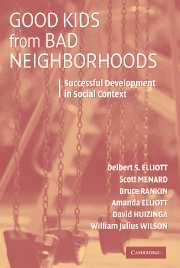Book contents
- Frontmatter
- Contents
- List of Tables and Figures
- Foreword by Richard Jessor
- Acknowledgments
- 1 Growing Up in Disadvantaged Neighborhoods
- 2 Growing Up in Denver and Chicago: The MacArthur Neighborhood Study
- 3 Good and Bad Neighborhoods for Raising Children
- 4 The Effects of Growing Up in a Bad Neighborhood: Initial Findings
- 5 Critical Dimensions of Neighborhood Organization and Culture
- 6 The Effects of Neighborhood Organization and Culture
- 7 Family Influences: Managing Disadvantage and Promoting Success
- 8 School Climate and Types of Peer Groups
- 9 What Matters Most for Successful Youth Development?
- 10 Successful Development in Disadvantaged Neighborhoods
- Appendix A
- Appendix B
- References
- Author Index
- Subject Index
2 - Growing Up in Denver and Chicago: The MacArthur Neighborhood Study
Published online by Cambridge University Press: 06 August 2009
- Frontmatter
- Contents
- List of Tables and Figures
- Foreword by Richard Jessor
- Acknowledgments
- 1 Growing Up in Disadvantaged Neighborhoods
- 2 Growing Up in Denver and Chicago: The MacArthur Neighborhood Study
- 3 Good and Bad Neighborhoods for Raising Children
- 4 The Effects of Growing Up in a Bad Neighborhood: Initial Findings
- 5 Critical Dimensions of Neighborhood Organization and Culture
- 6 The Effects of Neighborhood Organization and Culture
- 7 Family Influences: Managing Disadvantage and Promoting Success
- 8 School Climate and Types of Peer Groups
- 9 What Matters Most for Successful Youth Development?
- 10 Successful Development in Disadvantaged Neighborhoods
- Appendix A
- Appendix B
- References
- Author Index
- Subject Index
Summary
SYNOPSIS
The Neighborhood Study is one of a series of integrated studies about youth development in multiple social contexts – neighborhoods, families, schools, and peer groups. This work was undertaken by the MacArthur Foundation Research Network on Successful Adolescent Development. This study developed and tested the most detailed and comprehensive model of neighborhood influences on families, schools, peer networks, and individual developmental outcomes. Denver and Chicago were selected as study sites and probability samples of neighborhoods in each city were selected as study neighborhoods. The rationale for selecting these two cities and the neighborhoods in each city is described.
A neighborhood is both a physical place and a social context; its boundaries have both geographical and social dimensions. Different ways of identifying geographical boundaries are explored and different census-based boundaries are compared with resident's perceived boundaries. Based on this analysis of the validity of different approaches to identifying neighborhoods, we decided to use census block groups and tracts to define and select neighborhoods for this study.
In Denver, 33 neighborhoods (census block groups) were selected with an average size of 27 square blocks. The samples of youth and families from each of these neighborhoods contained, on average, 19 families and 25 youth for a total sample of 662 families and 820 youth aged 10—18. Forty neighborhoods (census tracts) were selected in Chicago, with an average size of 14 square blocks.
- Type
- Chapter
- Information
- Good Kids from Bad NeighborhoodsSuccessful Development in Social Context, pp. 11 - 32Publisher: Cambridge University PressPrint publication year: 2006



